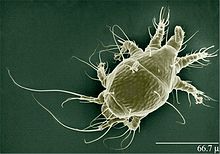| Tarsonemidae | |
|---|---|

| |
| Acarapis woodi | |
| Scientific classification | |
| Domain: | Eukaryota |
| Kingdom: | Animalia |
| Phylum: | Arthropoda |
| Subphylum: | Chelicerata |
| Class: | Arachnida |
| Order: | Trombidiformes |
| (unranked): | Heterostigmatina |
| Superfamily: | Tarsonemoidea |
| Family: | Tarsonemidae Kramer, 1877 |
| Diversity | |
| 45 genera, > 500 species | |
Tarsonemidae is a family of mites, also called thread-footed mites or white mites.
Only a limited number of tarsonemid genera (Steneotarsonemus, Polyphagotarsonemus, Phytonemus, Floridotarsonemus and Tarsonemus) are known to feed on higher plants while most species in this family feed on the thin-walled mycelia of fungi or possibly algal bodies.[1] Even among the plant-feeding tarsonemid mites, most are confined to areas of new growth where cell walls are thin and therefore easily pierced. However two species (the "broad mite" Polyphagotarsonemus latus and the "cyclamen mite" Steneotarsonemus pallidus) are able to feed on older leaves because of their ability to inject toxins during feeding (presumably of salivary gland origin) causing an increase of thin walled cells surrounding feeding sites.[1] This proliferation of new growth often results in leaves that appear stunted, puckered and twisted.[1]
Some Tarsonemidae are associated with insects. For example, three tribes of Acarapinae are insect parasites: Acarapini are parasites of Apis bees (the tribe includes notable pest Acarapis woodi), Coreitarsonemini live in odoriferous glands of leaf-footed bugs (Coreidae) and Podotarsonemini attach to wings of tetrigid grasshoppers.[2]
- ^ a b c L. R. Jeppson; Hartford H. Keifer & Edward William Baker (1975). "The Tarsonemidae Kramer". Mites injurious to economic plants. University of California Press. pp. 285–306. ISBN 978-0-520-02381-9.
- ^ Seeman, Owen Douglas; Baker, Michelle (2023). "A new species of Coreitarsonemus (Acari: Heterostigmata: Tarsonemidae) from the odoriferous glands of Amorbus rhombifer (Hemiptera: Coreidae)". Systematic and Applied Acarology. doi:10.11158/saa.28.12.7. ISSN 2056-6069.